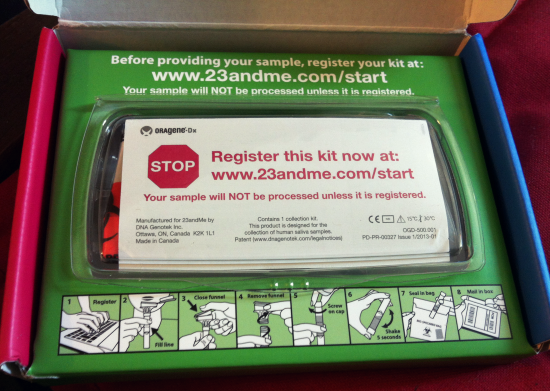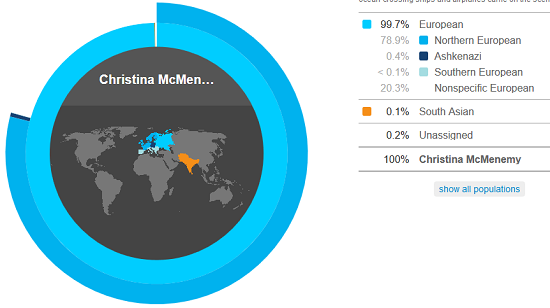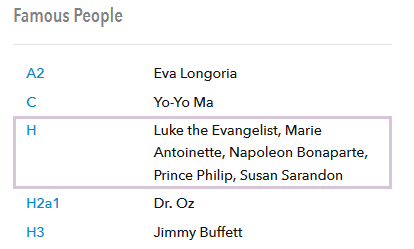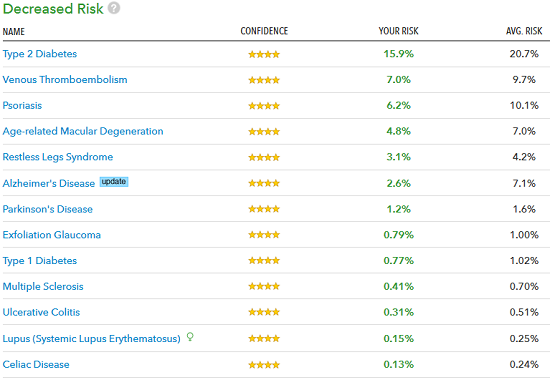I’ve always been fascinated with genetics, starting way back in 10th grade Biology when we were studying dominant and recessive genes and I discovered I had a genetic abnormality. I have one attached earlobe and one unattached earlobe – which is very unusual. After having my biology teacher laugh and call me a mutant (thanks, I really needed more help with NOT fitting in), I realized I wanted to learn more about the DNA sequence locked inside each of my cells that makes me who I am.
I first heard about 23andMe.com a few years ago, and immediately thought it was the coolest service out there. But at the time, we were recovering from bouts of unemployment and couldn’t afford to find out more about my health and ancestry from my DNA for fun. So when I was approached about reviewing the service, my fingers tripped over each other to reply as quickly as possible.
Note: Yes, this is a sponsored post, but I would have done this post even if it wasn’t. Finding out more about my unique DNA combo is something I’ve wanted to do for a long time – and sharing the results is something I’d likely have told you all about anyway.
I can understand why some people might not want to know about their DNA, and would rather keep the mystery rather than pull back the curtain on possible troubling health risks that could be in their future. I’m an open book, though, with the belief that knowing more about possible risks gives me the chance to prevent them if possible, and prepare for them even if I can’t prevent them.
Sending in a sample
The process to send your DNA sample to 23andMe is simple. They send you a “spit kit” will full instructions. First you go online to register your sample by creating an account and entering the barcode numbers on the sample tube to link that tube to your account. You then spit into the included tube until it reaches the fill line (it took about 3-4 minutes) then close the tube, breaking the seal to release a stabilizing fluid to keep your sample safe while in transit. Then the tube goes back into the prepaid box, you seal it, and finally ship it off to 23andMe.
 No, there’s no photo of me providing a sample. That’s just gross.
No, there’s no photo of me providing a sample. That’s just gross.
Waiting is the hardest part. It takes 6-8 weeks for your sample to be processed. You can log into your account during the wait and fill out surveys to help further research. It’s up to you whether you’d like your DNA results to be shared with the research arm of the company, 23andWe, so that your data can be used to contribute to further research in genetics.
The results – Health
I was terribly impatient, but finally the results were here a week ago! 23andMe makes it easy to help you dig through the data, separating it into health and ancestry information. The health data is also summed up in your key health recommendations, which is a good first place to begin.
In my key health recommendations, I found some amazing information based on my DNA. I learned that I could be sensitive to the blood thinner Warfarin (Coumadin) and based on my DNA I might require a lower dose than most people. This immediately made sense to me – my grandmother is on this medication and they’ve been having trouble getting the right dose for her because she’s sensitive to it as well.
My report also stated that I’m sensitive to the most common strain of norovirus – what most people call the stomach flu. I am super sensitive to it and seem to have stomach viruses more than others. (And suffer more than others – I’ve had to go to the hospital a few times for it.)
Out of a huge list of possible inherited conditions, I found that I was a carrier for only two: hemochromatosis (HFE-related) and alpha-1 antitrypsin deficiency. The first is a type of iron overload in the body – I don’t have it, but I am a carrier for two different mutations. For the second condition, my DNA combination causes only a slight build up of the protein in the liver and reduction of AAT in the bloodstream, but generally doesn’t increase my risk of liver and lung disease. That made me feel a little better after reading about how bad it could be. And it’s useful to know these things, as they could be passed down to my daughters.
They also screen for genetic markers for Parkinson’s and some forms of the breast cancer gene mutation. I was thankfully clear of these mutations and don’t have an increased risk for either of these. On the Health Risks screen, I saw my calculated risk of certain diseases based on how my DNA compares against the research that’s been done. It provides a list of increased risks and decreased risks.
Sadly, I saw my risk of melanoma is higher than the average – another reminder to be vigilant in my skin checks. But it felt good to see that I had a decreased risk of several nasty conditions.
There’s also a Drug Interaction screen as well as a Traits screen. From these I learned that I’m a fast metabolizer of caffeine (figures!) , it’s likely that I have a greater tendency to overeat than others, higher pain sensitivity, and that my muscle performance is likely that of a sprinter more than a marathoner. It’s no wonder I can’t make it past a 5K!
The results – Ancestry
After reading through a fantastic amount of health data, I then turned to my ancestry. I was pretty sure that I was northern European for most of my ancestry, but there were always hints about possible native American within my ancestry. So this was very interesting to view:
 No signs of Native American anywhere.
No signs of Native American anywhere.
I have no idea where the 0.1% South Asian Indian came from, but the results show I’m overwhelmingly northern European, the majority of that being Irish and British.
Note: women can only see their maternal line ancestry, since the paternal line is carried on the Y chromosome. To see your paternal line, ladies, you’d need to have your father share his genome on 23andMe.
I also discovered my haplogroup as well, and found that I share my haplogroup (H) with several famous names.

I’m an H – the ones with the box around them are very, very distant relatives.
Additional Info
In addition to just your own information, 23andMe has a huge community (over a quarter-million members) where people can discuss their genome information with others related to health, ancestry, or a shared interest in research. You can even be connected with people who are possible third-to-sixth cousins based on shared DNA chains. For those truly interested in the nitty-gritty details, you can also view your raw data, chromosome-by-chromosome.
When 23andMe was founded, the price of the personal genetic service was $1,000 – too steep for many people – but over time they have been able to reduce it to $99, making it more attainable to help put so much personal data at your fingertips. Check out the inspirational stories from some community members on how 23andMe has changed their lives.
I feel like I’ve barely scratched the surface of my 23andMe results (240 health reports takes a long time!) but I’m already so very happy with the service. I’ve discovered important data about my genetic health risks that will be valuable as I get older. I’m planning to share some of the data with my doctor, and I’ve already had long talks with my mom about family members and shared health issues.
We’re planning to request a sample kit for Aaron next. His mother was adopted, so there’s a large part of his family health history and ancestry we’d like to know. Revealing what’s in his DNA could provide so much valuable information for him.
If you’re a genetics geek like me, consider giving 23andMe a try. You just might find something awesome in your genetics, like being distantly related to a royal, or discovering you’re unable to detect some types of bitter flavors, or possibly find a major health risk that could provide the information you need to reduce your risks and have a longer life.
I’m happy to answer any questions about the service if you’re thinking about trying it.
My Disclosure: I received my 23andMe kit to facilitate this review. I am, however, happy enough that I’m purchasing another for Aaron. All opinions are 100% my own, including my opinion that genetics are SO VERY COOL and being a genetics geek helped me ace the science portion of the ACT in high school when one section was on genome dominant/recessive behavior.
Official disclosure: I was selected for this opportunity as a member of Clever Girls Collective and the content and opinions expressed here are all my own.



Well, it’s pretty safe to say we are not at all related to one another. We got this test for my dad last Chanukah. While I see it more as an interesting form of entertainment at this point, it’s interesting info to have (esp. on older relatives) as our understanding of genetics increases. His background is also very heavily European, but I was hoping there’d be some genetic surprises in there somewhere.
So what about the big reveal- how much Neanderthal DNA do you have? 🙂
On the more serious side, he’s having surgery soon so this post reminded me to peek at his results and see if there’s something it might be good to share with the doctors medication-wise. (Though I wonder how much they’d welcome this info or whether they’d be rolling their eyes.)
Kim – haha, I forgot to include the Neanderthal DNA! I’m 2.7% Neanderthal, which is right on average with most Europeans. I was surprised to see Ashkenazi in my heritage, along with the tiny bit of South Asian. I’m expecting Aaron’s percentage of Ashkenazi to be significantly higher on his father’s side.
I think a personal genetics test could be helpful for surgery. I told my doctor I was having the test done, and she specifically asked me to share the health results with her. The blood thinner results were good to know, as was another trait study that indicated I’m more likely to have post-operative nausea – also true, as I’ve usually needed anti-nausea meds after surgery.
I agree with you that it’s mostly entertainment for me at this point, but it’s also fun to see some of my traits validated by my genes. 🙂
This. Is. So. Cool.
Cool! And thanks for the post! This is something that I have been interested in doing when I have some spare money lying around (like that ever happens!), for fun, and for reference given all my health craziness, just as something to have around. Been curious, so it’s nice to see a real review of it. 🙂